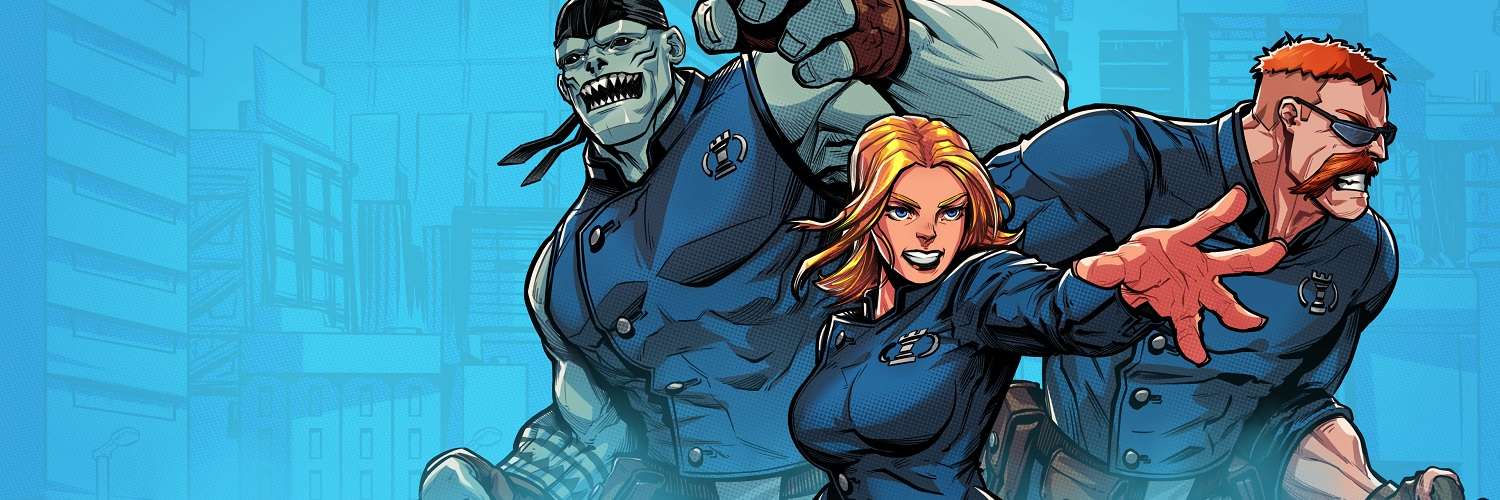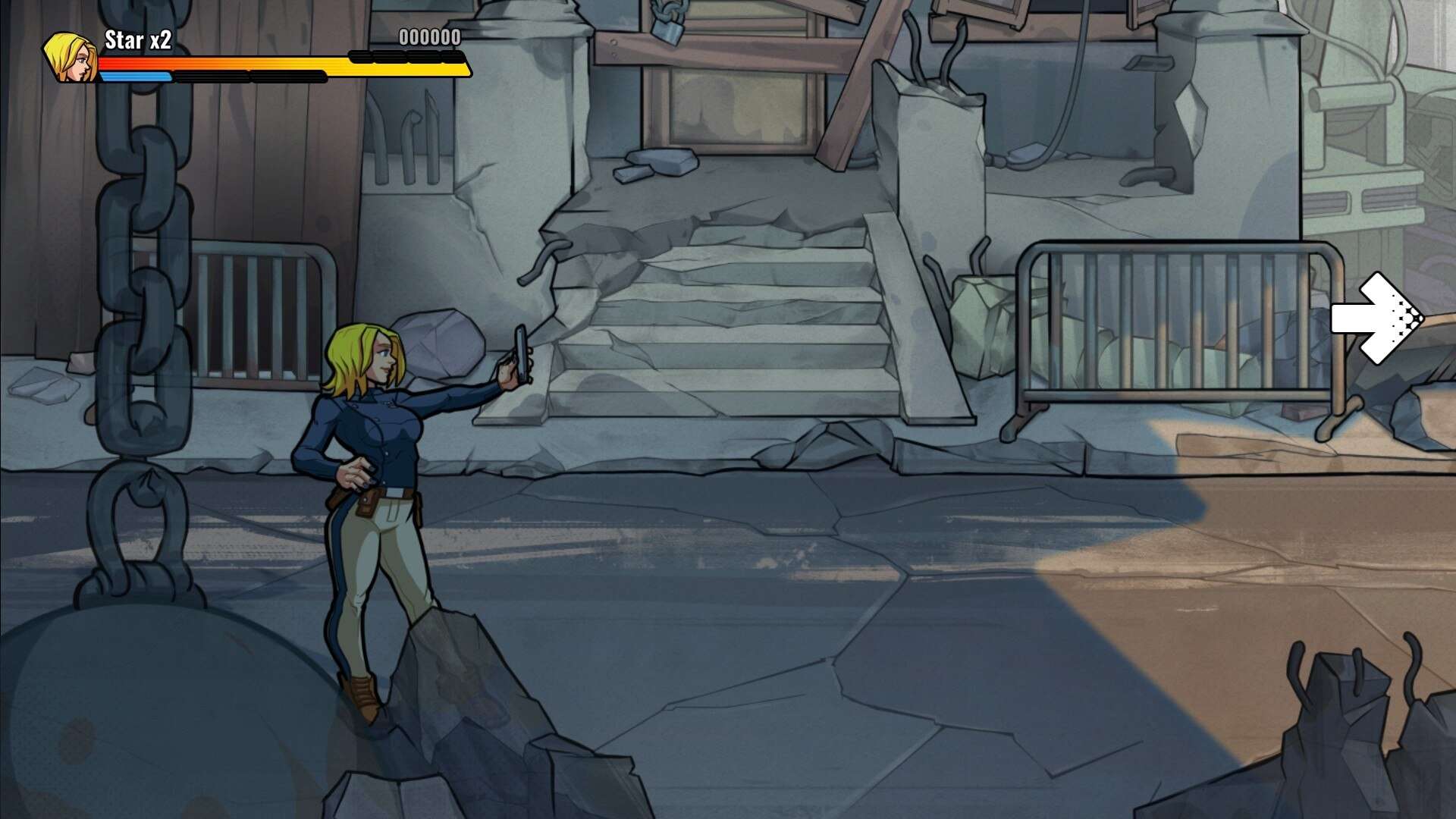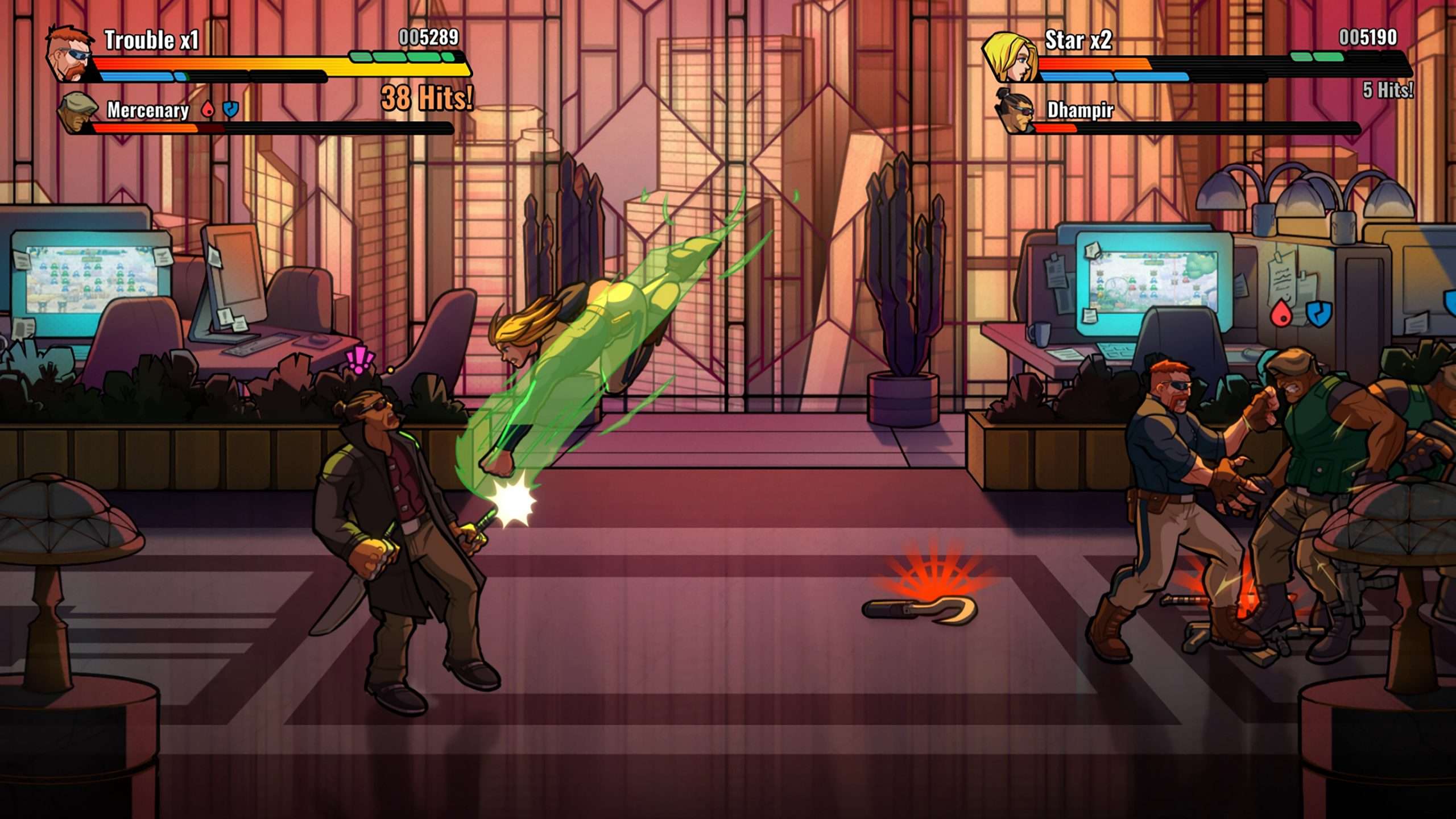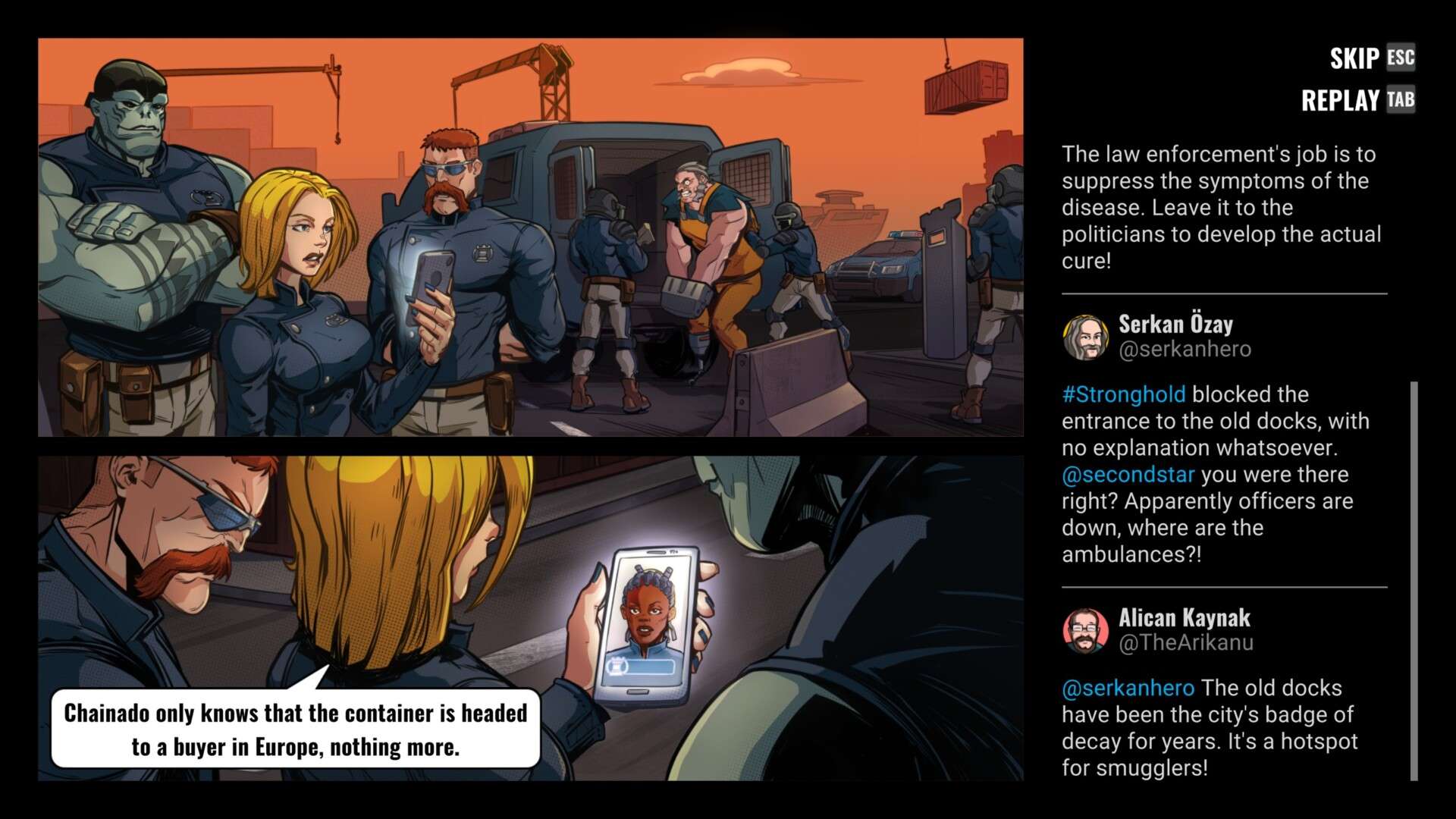
Mayhem Brawler PC Review
Mentioning scrolling beat ’em ups is going to be hard nowadays without mentioning the brilliant Streets of Rage 4 which was released last year. Everything is going to be compared to that as an example of how to release the old arcade genre in this decade. That is not to say you cannot have fun with the oldies; Streets of Rage 2 and Teenage Mutant Ninja Turtles: Turtles in Time are still timeless classics for the genre and hold up. It is more often than not that developers try to spice up the genre by giving it additional elements, such as loot or an experience system, as seen in the wonderful Dragon’s Crown by Vanillaware. Mayhem Brawler might look like Streets of Rage 4 from a quick glance at its screenshots, having art similar to Dotemu’s title, but is it as good?
One thing that stands out for Mayhem Brawler is its setting. The game is placed in an urban fantasy that is filled with supernatural beings that seem to have no issue being in the same place as standard humans. These fantasy characters cover beasts like werewolves, vampires, magicians and super-powered foes. This is the same for the three main characters that make up the Stronghold task force, a team of police offices with their own unique power that are there to serve and protect the streets against the latest corruption. On patrol, the three heroes get involved in a bust-up at the docks, which leads them into a sequence of events that put the city in danger as a new powerful weapon based on a dead superhuman body has found itself in the wrong hands. It’s down to these super cops to use excessive force and protect the city.

These playable heroes, allowing for local-only, three-player cooperative play (supports Steam Remote Play), cover the typical 90s scrolling beat ’em up roles that can easily be related to Streets of Rage‘s casting for good reference points for fans of the genre. Trouble is the all-round character, the Axel of the group, where he has werewolf hands to deal claw damage. Star is the light, female character (Blaze) who has telekinetic power with her speedy movement and also some unhealthy obsession with social media and taking selfies (#GetHelpStar). The last one, Dolphin, is a muscly grey mutant that smashes enemies with his strong hits (Max). All characters fit their distinct gameplay roles and are a blast to play. I do wish there were more characters to pick from, as three is rather limiting. This is especially so when you look at the game’s world and the potential characters that could have been created from its bizarre monsters. Even if it means taking some of the foes that the player battles as unlockable bonus characters to play because that would still make for some cool additions. Who does not want to play as the Blade clone vampire fighters, the wanna-be martial arts rats that are not named Splinter, or a wizard? It is such a missed opportunity.
Story mode is the only available game mode from the get-go. Beating this will then unlock the classic Arcade Mode. Story mode allows for infinite continues that spawns the player back at the start of the stage they died on. Arcade Mode goes down the more traditional route where you cannot continue and therefore have to start from the beginning of the game again. This is more challenging and is probably something to jump into once becoming comfortable with the game and learning its enemy spawning patterns and behaviour from within the Story Mode. On top of this, there are four difficulties to overcome, giving more challenge to people who want to push themselves, either in the less demanding attributes of Story Mode or the everything-is-on-the-line approach of Arcade Mode.

Brawling on the streets is mostly familiar for fans of the genre. There are buttons for an attack, jumping, and special moves. The attack button strings together a basic combo string, with no other way to alter it into branching combos unless leading into a special move or a jump/dash. Dashing can do forward rushing hits or mixed with a jump leads into a big damage dive attack to the ground. One thing to mention is special attacks are powerful in this game and come in two forms. First, if the button is pressed with no direction, it will do an area of effect attack around the player but if holding a direction then it becomes focused on being a forward attack. Special moves can get the player out of many situations, such as when overwhelmed by the enemy or even when grabbed by a foe to cancel out of their attack animation. Special attacks use a blue metre bar, which holds up to three charges. This makes a change from the typical special attacks in beat ’em ups because normally using one takes away a percentage of health, but in Mayhem Brawler, the metre fills up fast by either getting hit or picking up items off the ground.
Combat is not as open as Streets of Rage 4. There are limitations and no free-flowing combo system, which gives it that early 90s beat ’em up feel. That is not necessarily bad, since it is still enjoyable, and fans will like the frantic action available, it is just that it feels distinctly old. Weapons are common items to pick up, either from destructible environmental objects (barrels, boxes) or enemies. Weapons range from katanas, baseball bats, pistols, machine guns, and many more. Their use is short, breaking after a few hits/shots, but since there are times where there are four+ weapons on the ground, it is rare to be without the option to use one within a minute of gameplay. This does help somewhat with the basic combo system, but still, since players are repeating the same combos with weapons, or mashing melee and finishing with a dash, special, or grab means it eventually gets old after a few hours of play with nothing else but the two game modes.

There is a block mechanic that takes a while to get used to, as blocking is not normally a thing in the genre. Blocking stops incoming attacks, both physical or range in exchange for a small amount of health loss. It is actually rather handy to use, but my mind was so ingrained with games not having this that it took me time to train myself to get into the habit of using it. Blocking can get you out of tricky situations, then retaliate after absorbing the onslaught of attacks from the CPU controlled enemies.
Enemies are standard in their attack patterns, there is nothing here that has not been seen in other similar games, but one thing that is new is the condition icons that appear above the enemy. These indicate that they have a debuff/buff. This could be things like a rubber duck to acknowledge this enemy is dazed, so will take longer to get up and cannot dash. A broken shield means their resistance has decreased (more damage taken) or the purple exclamation mark to alert that this enemy is about to do a special attack. Payback is the one I find most helpful. There are times in the beat ’em up genre where enemies have invincibility on wake up and get free hits in if you try to attack while they are doing this. Normally players have to memorise this pattern, but the symbol above the enemy now alerts to this, so players know the enemy will throw out an unblockable attack while attacking them. These types of moves do interrupt the flow of the action, but it is something the genre has always had to keep players from overwhelming bosses or powerful standard enemies, just now it is easier to react to that.

Level design is simple. There is nothing that becomes a hazard to the player, no mines, no lasers beams, no sentry drones, just simple level design with themes across streets, subway, sewer, lab, and a few others. Levels are filled with many objects that can be broken or picked up and thrown, leading to the countless weapons and items on the ground, but the stages are never the enemy. Mayhem Brawler does have branching paths, so even though getting through the game is across seven stages, there are actually 14 different stages. Depending which stage was selected after finishing the previous one can change which final stage appears and what the ending will be, which there are three. This helps with replaying the game, as a single playthrough is short. The first time I beat the game it took me around 68 minutes, if you average that out across seven stages, then that is around 9 ½ minutes per stage, not exactly lengthy.
Mayhem Brawler visually has many similarities to Streets of Rage 4. Both games have gone for the thick black ink outline comic book style for its characters and environment. With this title, the darker tone gives off a moody vibe of a dangerous city. There are bright elements of colour scattered around, especially with some of the game’s special moves, but this is purposely given a darker than natural tone to present a grungy, dirty place. The game in motion looks great, with hand-drawn animations acting smoothly. The comic inspiration is also present in the game’s comic book scenes that pop up between each stage. There is a clear love for comics here, and with great art in both the game assets and presentation, this is hitting all the right notes for a polished-looking scrolling beat ’em up.

The opposite is sadly the case for the soundtrack, as this is the weakest link in Mayhem Brawler; it is a rather meh rock-focused musical score. There are a couple of catchy tunes, but the issue is that none of it is memorable. It works fine to back up the action, but when you think of a scrolling beat ’em up you can often hearing the music playing in your mind, but it would be hard for me to think of one right now for Mayhem Brawler. One thing that makes up for it is at least the sound effects are good, giving off impactful sounding punches, kicks, and connection of pipe on skull. The voice acting isn’t half bad either.
Mayhem Brawler is an enjoyable scrolling beat ’em up with a neat theme behind it that fully embraces the 90s design of the genre while throwing in some modern visuals to give it that grungy, dark comic book vibe. I feel Mayhem Brawler is aiming for people who are already fans of the genre, the ones that know how the games used to play back in the arcades. There is a lack of depth to the mechanics, but some cool features are refreshing to see for the genre, such as enemy conditions and the block button that offer more tools for surviving the challenge of the harder difficulties. In the end, this is a fun, simple brawler that allows three people to play together, but one that is short-lived – the game could have done with more modes and characters. In a time where rival games are doing it better, it was always going to be difficult to rival Streets of Rage 4 without doing something exceptional. Mayhem Brawler is not that, but I am not sure it was ever trying to be. Instead, I think the developers wanted to give fans more decent beat ’em up action, which the developers have successfully done.
